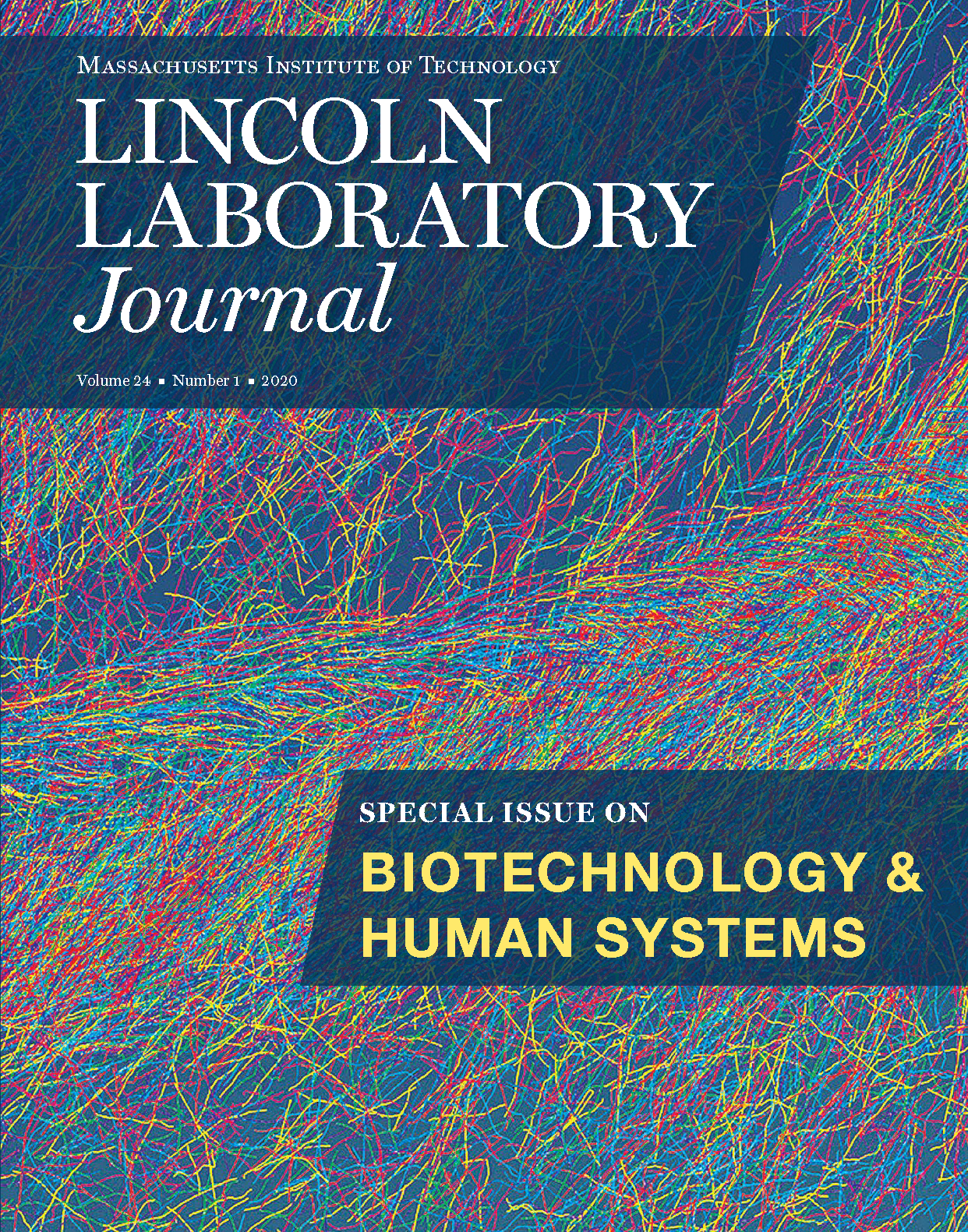Lincoln Laboratory Journal
The Lincoln Laboratory Journal showcases some of the Laboratory's most innovative and high-impact work, in fields ranging from air traffic control to bioagent sensing to parallel computing. The Journal consists of in-depth feature articles written by Laboratory staff members as well as shorter "Lab Notes" written by the Journal editors.
Current Issue

Volume 24, Number 1 - 2020
Biotechnology & Human Systems
Letter from the Director
Eric D. Evans
Introduction: History of Lincoln Laboratory's Bioengineering Research
Edward C. Wack and Jeffrey S. Palmer
Lincoln Laboratory applies expertise in systems analysis, sensors, signal processing, synthetic biology, and brain and cognitive sciences to biotechnological solutions for identifying and remediating physiological, neurological, and cognitive problems impacting the health and performance of U.S. warfighters, veterans, and civilians.
Noninvasive Biomarkers of Neurobehavioral Performance
Thomas F. Quatieri, James R. Williamson, Adam C. Lammert, Kristin J. Heaton, and Jeffrey S. Palmer
Neurological and psychological conditions, such as major depressive disorder, Parkinson's disease, and traumatic brain injury, are prevalent in civilian and military populations. To complement clinical assessments of such conditions, Lincoln Laboratory is developing neurobehavior-based biomarkers paired with neurocomputational biophysical models to identify neurobehavioral changes in a patient.
Fundamental Brain Research
Thomas F. Quatieri, Laura J. Brattain, Todd A. Thorsen, Gregory A. Ciccarelli, Shaun R. Berry, Jeffrey S. Palmer, Satrajit S. Ghosh, and Kwanghun Chung
Lincoln Laboratory and MIT campus have teamed up in several areas of fundamental brain research, pushing the boundaries of novel brain imaging and neural manipulation techniques and codifying knowledge with neurocomputational models.
Open Body Area Network Physiological Status Monitor
Brian A. Telfer, Kate Byrd, and Paula P. Collins
Lincoln Laboratory developed and transitioned to industry a prototype wearable sensor that monitors the thermal-work strain of an individual. The system produces a simple real-time actionable alert on the individual's physiological status that is then shared on an Android smartphone.
Understanding Noise-Induced Auditory Damage
Christopher J. Smalt, Paul T. Calamia, Shakti K. Davis, Joseph J. Lacirignola, and Thomas F. Quatieri
Lincoln Laboratory is conducting R&D to improve the understanding of the impacts of noise on the auditory system. We are also developing metrics that predict the likelihood and severity of these impacts in order to inform the development of hearing protection devices that will prevent, or mitigate, hearing impairments.
Model and Personal Sensor for Metabolic Tracking and Optimization
Lawrence M. Candell, Gary A. Shaw, and Kyle J. Thompson
Lincoln Laboratory has developed a novel metabolic fuel model and low-cost breath sensor for measuring, tracking, and enhancing metabolism. The model can provide guidance for optimizing a person's diet and activity to maintain metabolic health and to improve athletic performance and endurance.
Noncontact Laser Ultrasound for Biomedical Imaging Applications
Robert W. Haupt, Charles M. Wynn, Matthew R. Johnson, Jonathan R. Fincke, Xiang Zhang, Brian W. Anthony, and Anthony E. Samir
A collaborative effort involving Lincoln Laboratory is developing a noncontact laser ultrasound system that acquires images of the human body’s interior without touching the patient. The system could expand the role of imaging systems inside and outside the hospital center.
Biomechanical Sensing and Algorithms
Joseph J. Lacirignola, James R. Williamson, Shakti K. Davis, and Whitney T. Young
Researchers at Lincoln Laboratory have been developing models, algorithms, and force-sensing shoe inserts that can help determine if a soldier's performance has degraded because of fatigue or an injury. Monitoring an individual's gait changes with these systems could warn of and help prevent musculoskeletal injuries.
The Impact of Host-Based Early Warning on Disease Outbreaks
Mark A. Hernandez, Lauren E. Milechin, Shakti K. Davis, Richard A. DeLaura, Kajal T. Claypool, and Albert J. Swiston
Lincoln Laboratory investigated how early warning of exposure to pathogens could shape health care responses to disease outbreaks. Basing their analysis on the capability of an algorithm that predicts pathogen exposure in individuals before symptoms of disease occur, the research team evaluated the effects of early warning on strategies for mitigating a widespread outbreak.
Complex DNA Mixture Analysis
Darrell O. Ricke, Martha S. Petrovick, Catherine R. Cabrera, Eric D. Schwoebel, and James C. Comolli
A Laboratory-developed suite of technologies enables rapid analysis of samples that contain DNA from multiple sources. These technologies process 100 million DNA sequences in five minutes and compare a DNA profile against a database of 20 million profiles in five seconds. These capabilities are aimed at helping law enforcement and national security professionals identify suspected criminals or terrorists, or their relatives.
Synthetic Biology
Peter A. Carr, Johanna Bobrow, James C. Comolli, Nicholas J. Guido, Frances E. Nargi, Todd A. Thorsen, David I. Walsh, Matthew E. Walsh, Scott T. Wick, and Catherine R. Cabrera
Synthetic biology research at Lincoln Laboratory is aimed at advancing the field's foundational technologies to enable diverse applications, such as safeguarding human health, creating new materials, and responding to the challenges of climate change.
Lab Notes
- An Instrument to Transform Back Surgery › The design of a new laser-based scope could offer a less invasive, more precise way to remove tissue that causes back pain and immobility.
- Fluorescence Imaging for Surgery › A near-infrared fluorescence imager helps surgeons quickly locate microtumors.
- Diamond Sensors for Brain Imaging › A new detector uses a defect in diamond to sense faint magnetic fields emanating from the brain.
- A Nearly Neuron-Sized Brain Sensor › Lincoln Laboratory is developing what could be the world's smallest wireless, implantable device to measure neural activity in the brain.
- Progress Toward Wearable Pulse Oximetry › New algorithms and functional fibers clear a way for monitoring blood oxygen saturation on the go.
- Expanding the Potential of Medical Data with Polystores › A new approach to integrating medical information from multiple databases aims to improve diagnoses and treatment.












